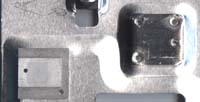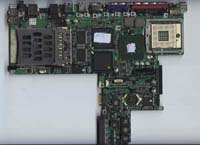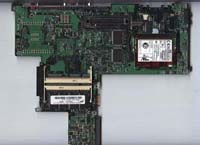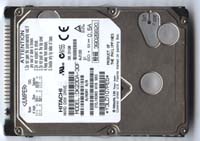Compaq Presario 2800 Pentium 4-M 1.7GHz Notebook
by Matthew Witheiler on May 10, 2002 12:18 AM EST- Posted in
- Laptops
Another exciting feature of Powerplay is its ability to control both the core speed and voltage supplied to the chip depending on use. Similar to the enhanced SpeedStep technology used on mobile Intel processors with the -M designation, the Mobility Radeon 7500 can dynamically clock itself depending on need. This is called "Power on Demand" by ATI and really has the potential to save quite a bit of battery power. In our test system the Mobility Radeon 7500 in the Presario 2800T underclocked itself to a 66MHz clock when in a static environment and shot up to the standard clock speed the second a 3D game or application was started. The system runs at either 66MHz when in idle mode or 270MHz when the graphics chip is being used and the switch is transparent to the user. The Mobility Radeon 7500 also has the ability to reduce the refresh rate of the system's LCD when in battery mode, saving additional power. The solution seems ideal for those wanting a mobile gaming system, as the system does not waste any precious battery power when not being put to use.
The final component to Powerplay is voltage throttling. Although the feature was not enabled on our Presario 2800T (likely because Compaq wanted a shorter time to market), the Mobility 7500 has the ability to alternate between 1.2 volts and 1.5 volts depending on power state. In AC mode the system defaults to the 1.5 volt setting but on battery power the voltage automatically drops down to 1.2 volts. The voltage setting in battery mode can be overridden via a tab in the display properties settings. All the above features combine to produce one killer mobile GPU that doesn't kill battery life.
The Mobility Radeon 7500 in our Presario 2800T was mounted on the top of the motherboard, to the upper left of the 845MP northbridge. Like the northbridge, the Mobility Radeon 7500 chip is cooled by transferring heat from the graphics core to a metal plate that support and shields the notebook. Below you can see the section of the plate where contact is made.

The top of the motherboard also held 32MB of the system's 64MB video memory. The additional video memory was mounted on the bottom of the motherboard.
Flipping the motherboard over shows a variety of components, including the system memory, the modem, and the Analog Devices AD1886A AC'97 audio codec.
The Presario 2800T that we received used a 30.0GB Hitachi DK23DA-30F hard drive. The drive spins at 4200RPM and has a 13ms access time. This drive is very similar to the Toshiba drives used in the WinBook and Toshiba notebooks that we have seen and, like the others, is not the fastest hard drive out there.
The two speakers on the Compaq Presario 2800T are located on the front of the system and sounded on par with other notebook sound systems.
On battery power the system runs off of an 8-cell lithium ion battery. Unfortunately we were not able to determine the output of the battery as our sample notebook's battery was unlabeled and Compaq has not published the battery specs as of publication.
Our Presario 2800T came with a 15" SXGA+ TFT display that runs at up to 1400x1050. The system is also available with a 14.1" TFT XGA (1024x768) display and a 15" UXGA (1600x1200) display.















0 Comments
View All Comments